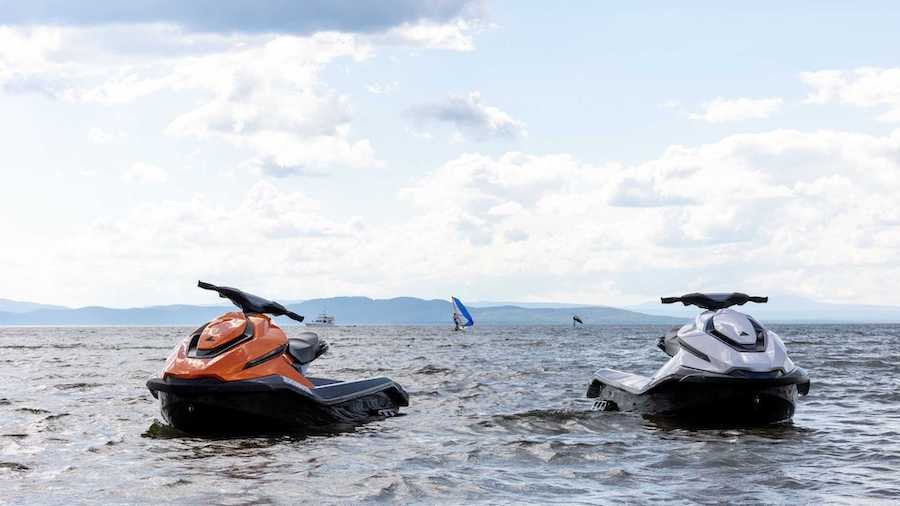2023 Taiga Motors Orca Electric Jet Ski First Ride: Zero Emissions Fun In The Sun

Jet skis can be exhilarating. There’s definitely something special about blasting across the water at 50 miles per hour on a hot summer’s day with the sun shining down and wind in your hair. However, personal watercraft (PWC) also burn through an insane amount of fuel. Hence they can cost a small fortune to run and, like all other gas-powered vehicles, are detrimental to the environment.
An electric jet ski, therefore, makes a lot of sense – with low running costs and limited environmental damage you immediately lose the two major drawbacks of traditionally powered PWC. Yes, jet skis are ultimately toys and unnecessary for day-to-day travel, but if you are buying one, electric is by far the most sustainable way to go.
Meet the Taiga Orca, the world’s first all-electric jet ski. Taiga Motors, founded in 2015, is a Canadian firm aiming to electrify the powersports industry. As well as the Orca jet ski, the company also produces the Nomad electric snowmobile.
I traveled to Burlington, Vermont to test a Founders Edition Orca on the beautiful Lake Champlain. The 490 square-mile Lake Champlain stretches between the US and Canada. When I rode the Orca, the weather was not on my side and I had to combat strong chop and rough winds - however, I think this only added to the fun.
Light And Powerful
The Orca was first unveiled back in 2019. The final production version is just as sleek as the first prototype and has a wide array of colors to choose from.
The Orca is powered by a 24-kilowatt-hour battery, which is roughly the same size as the first-gen Nissan Leaf’s pack. However, while the 2010 Leaf’s battery weighs 496 pounds, the entire Taiga Orca comes in at just 739 lbs. The Orca keeps its weight down thanks to a carbon fiber composite hull. However, it’s still rather heavy compared to gasoline jet skis, which typically weigh in the region of 500-700 lbs. Still, not bad for an EV.
Three versions of the Orca are currently available. The entry-level version is the 90-horsepower Orca Sport. A Performance version of the Orca with more color options produces 160 hp. The Carbon trim sits at the top of the Orca lineup and offers the same power as the Performance but has sportier looks and weighs less. The Founders Edition I rode is sold out.
The majority of ICE jet skis make between 100-150 hp, meaning the Orca Sport and Carbon are among the most powerful jet skis on the market. As a result of this power, they can tow wakeboarders and tubers.
Three modes are available on the Orca: Range, Sport, and Wild. However, the pre-production version I rode only had the first two modes available due to what Taiga called "safety reasons." Range mode cuts power down to 53 hp and can feel a bit sluggish at times. That said, Sport mode feels remarkably quick. Although you don’t get access to the full 160 hp Wild mode gives you (instead you get around 90 hp to play with) it still delivers plenty of thrills and feels like more than enough power. The Orca’s instant torque and brutal acceleration made me feel like I was driving a Tesla Model S Plaid on water.
On top of fantastic straight-line performance and acceleration, the Orca is remarkably nimble and agile – an impressive feat given it’s lugging around a 24 kWh battery pack.
The New Norm
Speed, range, and kilowatt usage are all shown on a 7-inch HD display in front of the driver. Being electric, the Orca is very simple to operate. Like a gasoline jet ski, you simply pull the right lever towards you to go forward and pull the left one to reverse. However, traditionally powered jet skis also have a neutral. Given the Orca is an EV, there is no neutral – instead, you just let go of the accelerator and you’re stalled. You don’t hear the electric motor, with all noise being drowned out by water splash.
Furthermore, the amount of storage space the Orca has is superb. You get a 15-gallon front storage compartment plus a smaller center console glove box.
In terms of range, Taiga claims you’ll get roughly 27 miles when driving enthusiastically. This translates to around 1-2 hours of use. For comparison, ICE jet skis usually hold around 15 gallons of fuel and get 50-75 miles of range.
When you’re running low on battery, you can plug your Orca into either a standard 110-volt outlet or a 240-volt level 2 charger. Taiga is currently working on its own network of fast chargers that it aims to deploy at marinas throughout North America. These fast chargers will be able to charge your Orca from 0-80 percent in around 20 minutes.
Customer deliveries of the Orca began on July 11, 2022. Currently, only the $24,000 carbon-clad Founders Edition is being delivered. However, the base 90-hp Orca Sport will go on sale in a couple of months. Pricing for the Sport will start at $17,490. For reference, the 160-hp Kawasaki Ultra LX starts at $12,699. That said, traditionally powered jet skis cost more to run (especially since marine/recreational gas is more expensive than your typical gasoline) and to maintain. However, there’s no hiding the fact that up-front the Orca is a very expensive piece of kit. Great fun and much more eco-friendly than a gasoline jet ski, but very pricey nevertheless.
The 160-hp Orca Performance starts at $19,490. Meanwhile, the top-of-the-line Carbon comes in at $26,500. The Sport, Performance, and Carbon models can currently be pre-ordered on Taiga’s website.
In summary, I left Lake Champlain thoroughly impressed by the world’s first electric jet ski. An electric PWC gives you instant torque, simple controls, and no engine noise. Plus it’s much kinder to the environment, even if it is fundamentally a toy.
